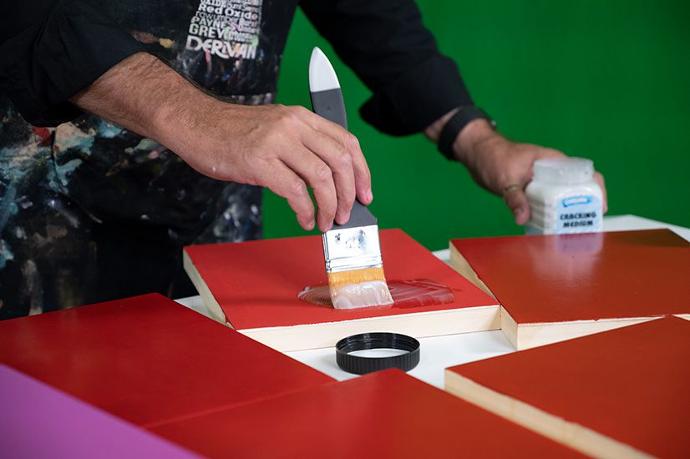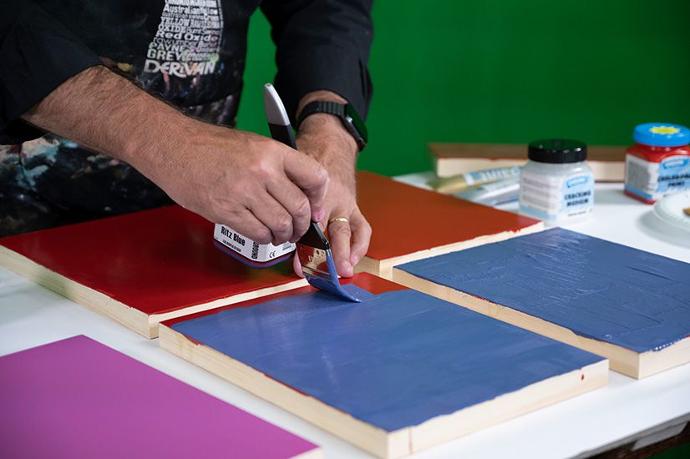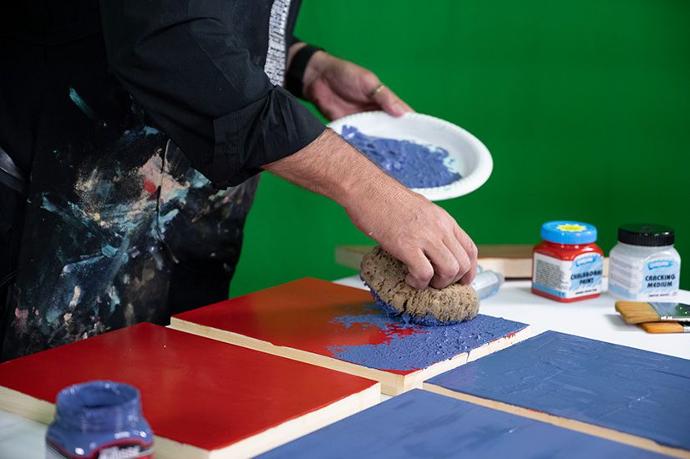
WHAT IS CRACKING MEDIUM?
PAINTED FINISH
CREATE A WEATHERED-PAINTED PATINA
Achieve a time-worn cracked and peeling paint effect. Cracking was used initially to make the paint look old. However, now it is also used as an effect in its own right. Also known as craquelure and crackling paint.
APPLICATION
As with any technique, if you've never tried this before, it is advisable to practice on some cardboard or scrap material first.
The process is pretty straightforward but requires some attention to the guidelines below.
* Derivan Cracking Medium has been made to crack with Derivan Chalkboard Paint and Derivan Student Paint. Other paint brands may work with this medium; however, we cannot guarantee performance.
Step 1 - Apply the base
Step 2 - Apply the sandwich coat of cracking medium
Step 3 - Apply the topcoat while the cracking coat is still tacky, thick coat of topcoat will achieve big cracks, thin you get smaller cracks
HOW TO
STEP 1
The first coat of paint laid down will be the colour that shows through the cracks. This first coat should be a water-based paint such as Derivan Student or, for larger areas, Derivan Chalkboard paint will give the best results. Leave this coat to dry before going to step 2. It is possible to omit this coat. If the desired effect is to show the surface as cracks, the Cracking Medium can be applied directly to any surface that acrylic paints normally adhere to. For example, if cracking on a wood surface and the desired effect is to have the paint cracking to reveal the woodgrain underneath, skip step 1 and start at step 2, ensuring the surface is clean and free of oil, grease and dust.

STEP 2
Once step 1 is dry, apply Derivan Cracking Medium (water-based) . You can use a brush, sponge applicator or roller (either a sponge or short nap roller). Apply the Cracking Medium so that it is as thick as possible but not so thick that it runs when the surface is held vertically. The Cracking Medium is designed to be a high-build coat; therefore, it is exceptionally viscous (thick). Do not be overly concerned with obtaining an even flat surface, as the Cracking Medium has a built-in flow agent which will allow it to level out as it dries. MAKE SURE YOU APPLY THE NEXT COAT WHILE THE CRACKING COAT IS STILL TACKY - only cover enough area so the cracking coat does not dry fully before you apply the top coat.
It is possible to thin the Cracking Medium down with water so it may be sprayed through a spray gun for larger areas. The amount of water used should not exceed 25%. Also, keep in mind that the medium must be at least 1-2mm thick to work. Always test the equipment to be used and the dilution rates before embarking on a large project.
Use approved respiratory equipment if using a spray gun, and do not inhale the Cracking Medium.

STEP 3
This coat cracks to reveal the coat applied in Step 1. Step 3 must be applied while the cracking medium of step 2 is drying - or still tacky. The paint used MUST be Derivan Chalk Board Paint or Derivan Student Paint (or Matisse background colours), as the Cracking Medium has been specially formulated to work with these paints. The unique formulation, unlike some other brands, allows for different types of cracks to be achieved and repeated with consistency. The Matisse Flow or Structure ranges will not always work as a topcoat with the Cracking Medium unless they are mixed with MM5 Matt Medium (this is discussed further in Cracking Metallic and Tube Colours).
When applying the topcoat, it is crucial not to re-work areas that have already been covered, as re-working an area can mix the cracking coat and top coat and stop the process (see below for more details).
TOPCOATS YOU CAN USE:
Derivan Students acrylic
Derivan Chalkboard paint
Matisse Background colours

The old methods of cracking using gum arabic and forced drying were quite unreliable. They relied on the different drying speeds to crack the paint. The climate had to be just right and the slightest mistake would result in the process not working.
The Derivan cracking process relies on a reaction between the topcoat of paint and the Cracking Medium which has been applied below it. Once the topcoat is applied, the cracking coat below becomes semi-liquid again and shrinks, taking with it the topcoat.
It is worth noting that the topcoat should be applied systematically, covering the surface and not going over an area that has already been covered. As described before, the paints have been designed not to crack; therefore, when the Cracking Medium is trying to shrink and take the topcoat with it, the topcoat is actually trying not to break apart. Therefore the thickness of the topcoat will dictate how big the cracks are. The thicker the topcoat the more easily it is able to hold together and resist cracking but when the Cracking Medium gets its way and manages to crack the topcoat, it will result in a very large crack. Thus the thicker the topcoat the fewer the cracks but they will be big ones. Conversely, if the topcoat is applied very thinly, the Cracking Medium will encounter less resistance from it and therefore result in many more cracks but they will be much smaller in size. Following on from that - if you brush in the one direction the overall pattern will be in that direction, if you apply the top coat using a cross hatch method you will find the resultant pattern will follow that same design. Applying the top coat with a sponge will give a much more rounded random pattern.
The types of cracks obtained depend on the thickness of the topcoat and the way in which it is applied. The bottom coat has no bearing on the outcome of the cracking pattern. The way in which the cracking coat is applied will not affect the pattern, unless it is too thin, in which case it just won't work.
The surface on which the finish is to be applied may have some bearing on the pattern. For instance, if very large cracks are desired, the topcoat will need to be applied very thickly. It will be necessary to have the surface horizontal as the weight of the paint may run and pull the cracking medium if the surface is vertical.
On frame mouldings or 3-dimensional pieces the paint, as it cracks, will tend to sink to the lower surface due to gravity. This may leave edges or sharp points exposed and make the piece look contrived. If the artist is new to this finish, it would be prudent to do some tests on an old sheet of cardboard etc. before a large project is attempted.
It is not necessary to varnish the cracking finish unless it is to be used on utility items with a lot of wear and tear or if it is to reside outdoors.
The cracking medium may also give a higher sheen to the first coat (i.e. the cracks) than the topcoat. A varnish may be used to even out the different sheen levels as well as protecting the finish from water and some wear and tear.
Use only a solvent-based varnish such as MM14 Final Varnish Gloss Finish or MM15 Final Varnish Matt Finish. DO NOT use a water-based varnish as a final coat as it may crack.